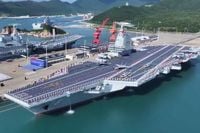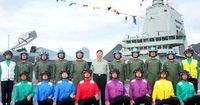China has officially commissioned its most advanced aircraft carrier to date, the Fujian, signaling a bold new chapter in the country’s efforts to project naval power far beyond its coastal waters. The ceremony, held on November 5, 2025, at a naval base on Hainan Island, was attended by top Chinese leader Xi Jinping, according to state media reports from Xinhua and confirmed by additional coverage from Global Times and AP. This event marks a significant milestone not only for China’s navy, already the world’s largest by number of ships, but also for the broader geopolitical landscape of the Indo-Pacific region.
The Fujian is China’s third aircraft carrier, but it stands apart from its predecessors in several key ways. Unlike the Liaoning, which was Soviet-made, and the Shandong, which was based on Soviet designs but built in China, the Fujian is the first carrier designed and constructed entirely by Chinese engineers at the CSSC Jiangnan shipyard. More importantly, it is the first in China’s fleet to feature an electromagnetic aircraft launch system (EMALS)—a cutting-edge technology previously found only on the U.S. Navy’s newest Ford-class carriers.
This leap in technology is no small feat. Traditional aircraft carriers use steam catapults or ski-jump ramps to launch planes, but these methods limit the size and weight of the aircraft that can take off. EMALS, by contrast, allows the Fujian to launch heavier aircraft with full fuel and weapons loads, significantly increasing the operational range and versatility of its airwing. According to AP, the Fujian has already conducted successful test launches of the KJ-600 early warning and control plane, the J-35 stealth fighter, and the J-15T heavy fighter. These capabilities grant the Fujian what the Chinese navy described as "full-deck operation capability," a substantial boost over the earlier carriers.
Greg Poling, director of the Asia Maritime Transparency Initiative at the Center for Strategic and International Studies, told AP, "Carriers are key to Chinese leadership’s vision of China as a great power with a blue-water navy." In other words, Beijing sees the carrier as a tool to extend its reach well beyond its home waters, challenging the U.S. Navy’s dominance in the wider Indo-Pacific. The Pentagon, in its latest report to Congress, called China "the only competitor to the United States with the intent and, increasingly, the capacity to reshape the international order."
China’s ambitions don’t stop at the so-called First Island Chain, which includes the South China Sea, East China Sea, and Yellow Sea. The Fujian is designed for operations as far out as the Second Island Chain, where the U.S. maintains key military facilities on Guam and elsewhere. Brian Hart, deputy director of CSIS’s China Power Project, explained to AP, "A carrier doesn’t really help you in the First Island Chain, but it’s key to that contest, if you want one, with the Americans in the wider Indo-Pacific."
The Fujian’s commissioning comes at a time when China is rapidly modernizing its military, aiming for a "modernized force by 2035 and a world-class navy by mid-century," as outlined by Xi Jinping. The carrier’s advanced technology and expanded operational radius are central to this vision. Song Zhongping, a Hong Kong-based military affairs expert, told AP, "China’s carriers cannot just operate near home, they must operate in the distant oceans and far seas to carry out various training and support missions. China is a great power and our overseas interests span the globe; we need to be globally present."
Japan, a close U.S. ally and regional neighbor, has expressed deep concern over China’s military expansion. Minoru Kihara, Japan’s chief cabinet secretary, stated, "We believe that China’s military intends to advance its operational capability at distant sea and air by strengthening sea power," adding that Japan would "calmly but decisively respond" if necessary. The specter of a potential blockade or invasion of Taiwan—an island China claims as its own—remains a flashpoint, especially with the new carrier’s ability to operate far from Chinese shores.
Despite these advancements, Western analysts caution that China’s carrier program is still maturing. As Aita Moriki wrote for Japan’s National Institute for Defense Studies, "This is not the 'completion of operational deployment,' but rather the 'starting point for challenges.'" Among the hurdles are improving the reliability of the EMALS and arresting gear systems, expanding the pool of qualified carrier-based pilots, and collecting operational data. Tang Meng Kit, a Singapore-based analyst, noted to AP that China hasn’t fought a war since 1979, and real-world combat readiness may lag behind the impressive technological displays. "It is possible that China’s capabilities are overstated, as real-world operational readiness lags behind its showcased arsenal," Tang said.
Numerically, China still trails the U.S. Navy in several respects. The U.S. currently operates 11 aircraft carriers, all of them nuclear powered, which allows for virtually unlimited range and endurance. China’s three carriers, including the Fujian, are conventionally powered, limiting their operational range and requiring more frequent resupply. However, China is already developing nuclear propulsion for future carriers and is expanding its network of overseas bases to support longer deployments. A fourth Chinese carrier is reportedly under construction, and Chinese shipyards have ramped up production of other advanced warships at a pace the U.S. struggles to match.
Beyond the carriers themselves, China showcased its growing military arsenal in a World War II Victory Day parade in early September 2025. The parade featured not only the Fujian’s aircraft but also hypersonic glide vehicles—missiles that are harder to intercept than traditional ballistic missiles—aerial and underwater drones, and advanced electronic warfare systems. These public displays serve multiple purposes: deterring rival powers, pressuring regional actors, expanding China’s global influence, and reinforcing domestic legitimacy.
The timing of the Fujian’s commissioning also followed a significant diplomatic moment. After a much-anticipated meeting between Xi Jinping and U.S. President Donald Trump in Busan, South Korea, the two leaders agreed to a temporary easing of trade tensions. Trump canceled planned port fees on Chinese ships for one year, and Xi agreed to relax export controls on rare earth elements critical to U.S. manufacturers, including defense companies.
Looking ahead, China’s naval modernization shows no signs of slowing. As Brian Hart put it, "Really across the board, China’s closing the gap. They’re fielding and building more aircraft carriers, they’re fielding more nuclear-powered subs, they are fielding more, larger destroyers and other vessels that carry a larger number of missiles. So they’re really catching up." Yet, as analysts stress, sophisticated equipment alone does not guarantee military readiness or victory in conflict. The real test will come as China’s navy gains experience operating these new assets far from home, in the unpredictable waters of international competition.
For now, the Fujian stands as a powerful symbol of China’s ambitions—and a reminder to the world that the balance of naval power in the Pacific is shifting, one carrier at a time.


